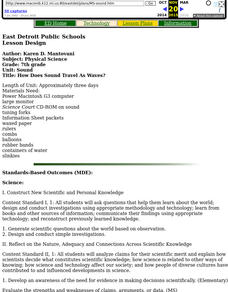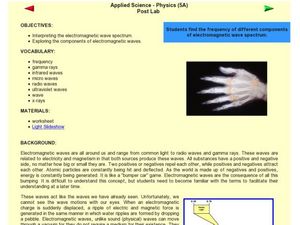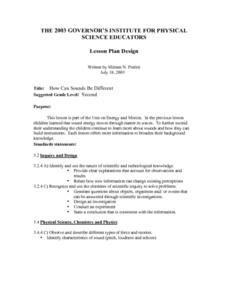Green Education Foundation
How Loud is Too Loud?
Ever wonder how loud a sound has to be to cause damage? Young scientists explore sound properties by researching decibel levels. They discuss how sound is perceived by our ears and our brains and why it can cause negative health effects...
Curated OER
Waves
Students identify the different parts of a wave. In this physics lesson, students explain how animals communicate using sound waves. They discuss the effect of Navy's sonar on dolphins and whales.
Curated OER
Hold Off on the Headphones
Students explore hearing loss caused by sound waves. In this physical science lesson plan, students will start by learning about waves and wave characteristics and move into sound waves. Students will study how sound effects their...
Curated OER
Waves Interference
Students identify different wave types and their characteristics. In this wave lesson students complete activities by activating tuning forks and interpreting data.
Curated OER
Woodwind Instruments and Pitch
Students explore musical pitch. In this cross curriculum musical instruments and "sound" physics lesson, students identify and describe common traits of woodwind instruments. Students research "pitch" and what causes pitch fluctuation by...
Curated OER
Physics 210: 24
In this physics 210 activity, students answer the question of the predicted modes of oscillations heard based on the information provided in the word problems. Students apply their understanding of sound waves to answer the questions given.
CK-12 Foundation
Violin
Learners explore the science of sound by considering the characteristics that make unique sounds. Through an interactive simulation, they adjust tension and string size and view the corresponding wavelength and amplitude changes.
Curated OER
Sound and Hearing
Students explore how sound travels. In this sound lesson plan, students complete seven activities where they observe the different characteristics of sound. Students make sound, watch sound happen, and learn about the ear. Students gain...
Curated OER
Interactive Notes - "Sound"
Third graders view a PowerPoint and participate in an experiment about sound. For this sound lesson, 3rd graders press on a slinky with different amounts of force to understand energy waves moving and echoing back. Students discuss the...
Physics Classroom
Wavelength
Physics class sure can have its ups and downs! The first in a series of seven interactives from the Waves and Sound series introduces young learners to the concept of wavelength. Scholars work through the interactive to discover the...
Curated OER
Applied Science - Physics Pre-Lab
Students describe the science of physics. In this Physics lesson, students observe examples of physics within their classroom. Students create a definition for physics.
Curated OER
Sound Waves; vocabulary review
In this science activity, students locate 28 words in a word search. The focus of the word search is vocabulary connected to the study of sound waves.
Curated OER
How Does Sound Travel As Waves?
Seventh graders participate in a number of activities designed to increase their understanding of how sound is generated and how it travels.
DiscoverE
Slinky® Science
Toys are great for learning about physics. Scholars use Slinky® toys to study Newton's laws of motion and types of energy. After a little play, they then model longitudinal and transverse waves with the Slinky® toys.
Curated OER
Electromagnetic Wave Spectrum
Fifth graders examine electromagnetic wave spectrum. In this science instructional activity, 5th graders discuss the aspects of the electromagnetic wave spectrum and complete a worksheet identifying the parts of the spectrum.
Curated OER
Does that Sound Right to You?
Ninth graders are introduced to the components of compressional and transverse. They practice answering speed problems involving different mediums that waves travel trhough and then review the wave PowerPoint. They then visit physics...
Curated OER
Pitch
Students experience sounds with different pitches. In this pitch activity, students use open pipes as they are introduced to pitch, then make Straw Pan Pipes.
Curated OER
Light
Light is such a fascinating subject. This instructional activity does a great job of illuminating the mysteries of light for your young scientists. A series of demonstrations which are explained in the plan should help your charges to...
Broward County Public Schools
Force and Motion
Get the ball rolling with this upper-elementary science unit on forces and motion. Offering over three weeks of physical science lessons, this resource is a great way to engage the class in learning about simple machines, friction, the...
Curated OER
How Can Sounds Be Different
Second graders explore energy and motion. They investigate how sound energy moves in waves. Students explore how sounds are varied and how the instruments that make those sounds are built. They observe sounds being produced and predict...
Curated OER
Properties of Waves
Third graders observe and investigate wave properties and compare the properties of particles and waves. They fill a pie pan half full with water, place a toothpick in the center of the pie pan, then drop a marble into the pan and...
Discovery Education
It's Too Loud!
STEM scholars investigate sound attenuation by conducting an experiment in which they compare the farthest distance that they can hear a sound with and without ear protection.
Curated OER
Good Vibrations
Students demonstrate sound waves and make changes in the waves
resulting in changes in pitch. Students associate changes in pitch in various "musical instruments"with size and shape and the sound waves they produce.
Curated OER
Motion in the Ocean
How does the formation of currents and waves in the ocean happen? High schoolers will learn about the primary causes for ocean currents and waves by calculating a wave's amplitude and nautical mile speed. Then they will complete a...

























